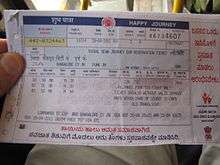Rail transport in India
Rail transport is an important mode of transport in India.
| Rail transport in India | |
|---|---|
| Operation | |
| National railway | Indian Railways |
| Statistics | |
| Ridership | 9.116 billion (2018)[1] |
| Passenger km | 1,149.835 billion (2017)[1] |
| Freight | 1.106 billion tonnes (2017)[1] |
| System length | |
| Total | |
| Electrified | |
| Track gauge | |
| 1,676 mm (5 ft 6 in) broad gauge | 64,298 km (39,953 mi)[1] |
| 1,435 mm (4 ft 8 1⁄2 in) standard gauge | Not available |
| 1,000 mm (3 ft 3 3⁄8 in) metre gauge | 3,076 km (1,911 mi)[1] |
| Two narrow gauges, 762 mm (2 ft 6 in) and 610 mm (2 ft) | 1,808 km (1,123 mi)[1] |
| Features | |
| Longest tunnel | Pir Panjal Railway Tunnel, 11.215 km (6.969 mi) |
| No. bridges | 133,160 (2011)[2] |
| Longest bridge | Bogibeel Bridge, 4.94 km (3.07 mi)[3] |
| No. stations | 7,349[1] |
| Highest elevation | 2,257 m (7,405 ft) |
| at | Ghum on the Darjeeling Himalayan Railway |
| Lowest elevation | 4 m (13 ft) |
| at | Barra Bazar and Honnavara Railway Station |
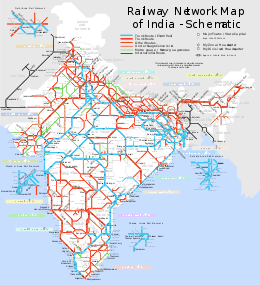
All main-line rail operations in India are handled by Indian Railways (IR), a state-owned organization of the Ministry of Railways. As of March 2017, the rail network comprises 121,407 km (75,439 mi) of track[4] over a route of 67,368 km (41,861 mi) and 7,349 stations.[1] It is the fourth-largest railway network in the world (after those of the United States, Russia and China).[5] Forty nine percent of the routes are electrified with 25 KV AC electric traction while thirty-three percent of them are double or multi-tracked.[1]
It is one of the busiest networks in the world, transporting 8.107 billion passengers and over 1.108 billion tonnes of freight annually, as of 2017.[1] Indian Railways is the world's eighth largest employer, with more than 1.308 million employees as of March 2018.[1] As of March 2017, IR's rolling stock consisted of 277,987 freight wagons, 70,937 passenger coaches and 11,452 locomotives.[1] IR owns locomotive and coach-production facilities at several locations in India.
The urban rail transit systems across the country are operated independently of Indian Railways. There are currently 11 operational rapid transit (also called 'metro') systems in ten cities in India. As of September 2019, India has 638 kilometres (396 miles) of operational metro lines and 502 stations. A further 500+ km of lines are under construction and 1200+ km of lines are proposed.
History
Rail transport in India began in the early nineteenth century.
1832–1852: Industrial railways
The first proposals for railways in India were made in Madras in 1832.[6] The first train in India ran from Red Hills to Chintadripet bridge in 1837.[6] It was called Red Hill Railway and used a rotary steam locomotive manufactured by William Avery. The railway was built by Sir Arthur Cotton and was mainly used for transporting granite stones for road-building work in Madras.[6] In 1845 Cotton built the Godavari Dam Construction Railway at Dowleswaram in Rajahmundry, used to supply stones for construction of a dam over Godavari.[6]
On 8 May 1845, Madras Railway was incorporated, and East India Railway (EIR) was incorporated the same year. On 1 August 1849 Great Indian Peninsular Railway (GIPR) was incorporated by an Act of Parliament. A "Guarantee System" providing free land and guaranteeing rates of return (5%) to private English companies building railways was finalized on 17 August 1849. In 1851 the Solani Aqueduct Railway was built in Roorkee, hauled by a steam locomotive called Thomason, named after a British officer. It was used for transporting construction materials for an aqueduct over the Solani river.[6] In 1852 the Madras Guaranteed Railway Company was incorporated.
1853–1924: Passenger railways and expansion
.jpg)
.jpg)
The first passenger train in India ran between Bombay (Bori Bunder) and Thane on 16 April 1853. The 14-carriage train was hauled by three steam locomotives: Sahib, Sindh and Sultan. It carried 400 people and ran on a line of 34 kilometres (21 mi) built and operated by the Great Indian Peninsula Railway.[7][8] This line was built in 1,676 mm (5 ft 6 in) broad gauge, which became the standard for railways in the country. In May 1854 the Bombay–Thane line was extended to Kalyan by building India's first railway bridges, the Thane viaducts, over Thane creek.[9] In Eastern India, the first passenger railway train ran from Howrah (near Calcutta) to Hoogly on 15 August 1854. The 39-kilometre (24 mi) line was built and operated by EIR.[10] In August 1855, EIR Express and Fairy Queen steam locomotives started hauling trains.[11] The first passenger train in South India ran from Royapuram and Veyasarapady (Madras) to Wallajah Road (Arcot) on 1 July 1856 on a 97-kilometre (60 mi) line built and operated by Madras Railway.[12]
On 24 February 1873 the first tramway, a 3.8-kilometre (2.4 mi) horse-drawn tramway, opened in Calcutta between Sealdah and Armenian Ghat Street.[13] On 9 May 1874 a horse-drawn tramway began operation in Bombay between Colaba and Parel. In 1880 Calcutta Tramways Company was incorporated.[14]
GIPR started its first workshops in Byculla in 1854 and Madras Railway set up their first workshop at Perambur in 1856. The railway boom continued with the incorporation of Bombay, Baroda, and Central India Railway (BB&CI) in 1855,[15]Eastern Bengal Railway in 1858,[16] and East Coast State Railway in 1890. Great South Indian Railway (GSIR) and Carnatic Railway merged in 1874 to form the South Indian Railway.
In 1897 lighting in passenger coaches was introduced by many railway companies. In 1902 the Jodhpur Railway became the first to introduce electric lights as standard fixtures. In 1920 electric lighting of signals was introduced between Dadar and Currey Road in Bombay.
1925–1950: Electrification and further expansion
The first railway budget was presented in 1925. The Oudh and Rohilkhund Railway was merged with EIR in the same year.[17][18] In 1930, the route of the Grand Trunk Express was changed to Delhi-Madras.
On 3 February 1925 India's first electric passenger train ran between Victoria terminus and Kurla, on 1500 V DC overhead traction[19] with locomotives provided by Cammell Laird and Uerdingenwagonfabrik companies. Later that year the VT–Bandra section was electrified with an elevated platform at Sandhurst Road.[19] Kurla–Kalyan and lines to Poona and Igatpuri were electrified in 1926[19] and the Bandra–Virar section was electrified by January 1928. On 1 June 1930 the Deccan Queen began running, hauled by a WCP-1 (No. 20024, old No. EA/1 4006) with 7 coaches, on the GIPR's electrified route from Bombay VT to Poona.[20]
The Frontier Mail made its inaugural run in 1928 between Bombay VT and Peshawar.[21] In 1929 the Grand Trunk Express began running between Peshawar and Mangalore[22] and Punjab Limited Express began running between Mumbai and Lahore. Technical advancements saw automatic colour-light signals first become operational on GIPR's lines between Bombay VT and Byculla in 1928[23] and were extended to the Byculla–Kurla section the following year.
1951–1983: Zonal re-organisation and further developments
India's railways were re-organised into regional zones beginning in 1951[24] with the creation of Southern Railway on 14 April and Central Railway and Western Railway on 5 November.[25] The post of Chief Commissioner of Railways was abolished and the Railway Board adopted the practice of making its senior-most member Chairman.[25] Also in 1951, the government of West Bengal entered into an agreement with the Calcutta Tramways Co. to take over its administrative functions. On 14 April 1952 Northern Railway, Eastern Railway and North-Eastern Railway were created.[25] On 1 August 1955 South-Eastern Railway was split from Eastern Railway, and the following year divisional systems of administration were set up for the various regional zones. In 1958 the North-Eastern Railway split to form a new Northeast Frontier Railway.[25]
In 1952 fans and lights were mandated for all compartments in all classes of passenger accommodation and sleeping accommodation was introduced in coaches. In 1956 the first fully air-conditioned train was introduced between Howrah and Delhi.[26] In 1966 the first containerized freight services began, between Bombay and Ahmedabad.
In 1957 India Railways took a decision to adopt 25 kV AC electrification and chose SNCF (French National Railway) as technical consultant.[27] The Main Line Electrification Project was established in the same year.[28] Raj Kharswan–Dongoposi became the first section to be electrified with 25 kV AC traction[27] with the first train running on 11 August 1960.[27] In 1966 electrification of several suburban tracks around Delhi, Madras and Calcutta was completed with the 25 kV AC system. In 1979 the Main Line Electrification Project was reconstituted into Central Organization for Railway Electrification (CORE).
1984–present: Rapid transit and later developments
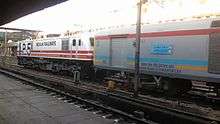

The Calcutta Metro became the first metro in the country[29] with the 24 October 1984 line between Esplanade and Bhowanipur (now the Netaji Bhawan station).[30] In 1988 the first Shatabdi Express was introduced between New Delhi and Jhansi (later extended to Bhopal), and was the fastest train at the time.[31] In 1993 air-conditioned 3-tier coaches were introduced as well as a sleeper class separate from second class. In 1999 South East Central was constituted. On 6 July 2002 the East Coast, South Western, South East Central, North Central, and West Central zones were created.[32] On 5 April 2016 Gatiman Express, India's fastest train at a maximum speed of 160 km/h (99 mph), made its first run from Delhi to Agra.[33]
India's first computerized ticketing and reservation was introduced at New Delhi in 1986. [34] In 1990 the first self-printing ticket machine (SPTM) was introduced. In September 1996 the CONCERT computerized reservation system was fully deployed at New Delhi, Mumbai and Chennai, and was completed nationwide on 18 April 1999. In 1998 coupon validating machines (CVMs) were introduced at Mumbai CST. Credit cards were accepted for booking tickets and reservations starting in 1999. Indian Railways launched its web site in February 2000[35] and began taking online train reservations and ticketing on 3 August 2002, which was extended to many cities in December.[36] On 26 September 2013 the Tatkal system of ticketing extended to ordinary trains.
On 16 January 1995 the first regularly scheduled services using the 2 × 25 kV system of traction started on Bina–Katni. On 5 February 2012 Western Railway switched completely to 25 kV AC traction, ending its use of 1.5 kV DC traction.[37] On 11 April 2016 Central Railway completed switching to 25 kV AC traction, ending the use of DC traction on the country's main-line rail network.[38] Indian Railways announced on 31 March 2017 that the entire rail network would be electrified by 2022.[39]
Rolling stock
Locomotives
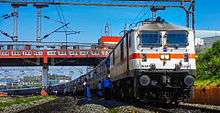
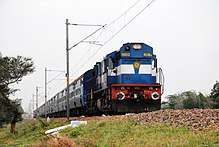
Locomotives in India largely consist of electric and diesel locomotives. The world's first compressed natural gas (CNG) locomotives are also being used.[40] Steam locomotives are used only in heritage trains.
In India, locomotives are classified according to their gauge, motive power, the work they are suited for and their power or model number. The class name, composed of four or five letters, encodes this information. The first letter denotes the track gauge; the second denotes their motive power, diesel or alternating current (electric); the third letter denotes the type of traffic for which they are suited (goods, passenger, multi or shunting). The fourth letter used to denote the chronological model number but from 2002 denotes the horsepower range for diesel locomotives. Electric locomotives don't come under this scheme and not all diesels are covered; for these, the fourth letter denotes their chronological model number.
A locomotive may have a fifth letter in its class name which denotes a technical variant, subclass or subtype, indicating a variation in the basic model or series, possibly different motors or a different manufacturer. With the new scheme for classifying diesel locomotives (as mentioned above) the fifth letter further refines the horsepower indication in 100 hp (75 kW) increments: 'A' for 100 hp, 'B' for 200 hp, 'C' for 300 hp, etc. In this scheme, a WDM-3A refers to a wide-gauge diesel multi-use 3100 hp loco, while a WDM-3D would be a 3400 hp loco and WDM-3F would be 3600 hp loco.
Note: This classification system does not apply to heritage steam locomotives which retain their historical class names such as M class or WP class.
Diesel locomotives have been fitted with auxiliary power units which save nearly 88% of fuel while idling.[41]
Goods wagons
The number of goods wagons was 205,596 on 31 March 1951 and peaked at 405,183 on 31 March 1980, after which it declined to 239,321 on 31 March 2012. The number is far less than that required for demand and Indian Railways loses freight traffic to road carriers. The railway carried 93 million tonnes of goods in 1950–51, increasing to 1010 million tonnes in 2012–13.[42]
However, its share in goods traffic is much lower than road traffic. In 1951, its share was 65%, and the share of the road was 35%. Now the shares have been reversed, and the proportion of railways has declined to 30% while the share of road has increased to 70%.
Since the 1990s, Indian Railways has stopped single-wagon consignments and provides only full-rake freight trains.
Wagon types include:[43] BOXN = BOXN-HL, BOXN-HS, BOXN-HL, BOXN-CR, BOXN-LW, BOXN-AL, BOXN-EL, BOBYN, BCNA, BCNHL, BTPN, BCACBM, BCCN, BOBRN, BRH, BTPGLN, VVN.
Passenger coaches
IR has several types of passenger coaches. (See §Passenger services, below.)
The coaches used in IR are produced at Integral Coach Factory, Chennai ; Rail Coach Factory, Kapurthala and Modern Coach Factory, Raebareli. This includes the new Linke-Hofmann (LHB) coaches.
Electric multiple unit (EMU) coaches are used for suburban traffic in large cities – mainly Mumbai, Chennai, Kochi, Delhi, Kolkata, Pune, Hyderabad and Bengaluru. These coaches numbered 7,793 on 31 March 2012. They have second-class and first-class seating accommodation.
Passenger coaches numbered 46,722 and other coaches (luggage coach, parcel van, guard's coach, mail coach, etc.) numbered 6,560 on 31 March 2012.
Manufacturing
The Chittaranjan Locomotive Works in Chittaranjan makes electric locomotives. The Diesel Locomotive Works in Varanasi makes diesel locomotives. The Integral Coach Factory in Perambur, Chennai makes integral coaches. These have a monocoque construction, and the floor is an integral unit with the undercarriage. The Rail Coach Factory in Kapurthala also makes coaches. The Rail Wheel Factory at Yelahanka, Bangalore and Rail Wheel Plant, Bela, Chhapra, Bihar manufacture wheels and axles. Diesel-Loco Modernisation Works, Patiala upgrades the WDM-2 diesel loco from 2,600 to 3,100 hp (1,900 to 2,300 kW). Some electric locomotives have been supplied by BHEL, Jhansi and Palakkad, and locomotive components are manufactured in several other plants around the country.[44]
Network
Tracks
.svg.png)
As of March 2017, IR network spans 121,407 km (75,439 mi) of track length, while the route length is 67,368 km (41,861 mi).[45] Track sections are rated for speeds ranging from 80 to 200 km/h (50 to 124 mph), though the maximum speed attained by passenger trains is 180 km/h (110 mph). As of March 2017, most of the broad-gauge network is equipped with long-welded rails, pre-stressed concrete (PSC) sleepers and high tensile strength 52kg/60kg 90 UTS rails.[45]
1,676 mm (5 ft 6 in) broad gauge, is the predominant gauge used by IR and spans 61,680 km (38,330 mi) of route (92% of total route network). It is the broadest gauge in use across the world for passenger movement.[45] Broad gauge generated 100% of the freight output (Net tonne-Kilometres) and more than 99% of the passenger output (Passenger Kilometres) in the fiscal year 2016-17.[46]
The 1,000 mm (3 ft 3 3⁄8 in) metre gauge tracks; 762 mm (2 ft 6 in) and 610 mm (2 ft) narrow gauge tracks are present on decreasing number of routes. All of these routes, except the heritage routes, are being converted to broad gauge. The metre gauge tracks were 3,479 kilometres (2,162 mi) (5% of total route network) and narrow gauges tracks were 2,208 km (1,372 mi) (3% of total route network) as of 31 March 2017.[45]
Urban rail transit systems in India mostly use standard gauge tracks. These systems are operated by metro/tram rail corporations which are independent of Indian Railways. Trams in Kolkata, the only remaining tram service in the country uses standard gauge tracks. The Line 1 of Kolkata Metro and Delhi Metro use same broad gauge tracks as main-line railways. All other metro lines — constructed, under construction, future — use standard gauge tracks.[47] Metro trains operate in Delhi, Bangalore, Chennai, Mumbai, Hyderabad, Jaipur, Kochi and Lucknow. Gurgaon has a Metro system operated by a private organisation. Metro tracks are being constructed or planned in all million-plus cities in the country.
Electrification
As of 31 March 2019, IR has electrified 51% or 35,488 km (22,051 mi) of the route kilometers and 46% or 55,240 km (34,320 mi) of the total running track. India uses 25 kV AC traction on all of its electrified tracks.[48]
Railway electrification in India began with the first 1500 V DC electric train between Bombay Victoria Terminus and Kurla on Harbour Line in 1925. Steep gradients on the Western Ghats necessitated the introduction of electric traction on the Great Indian Peninsula Railway (GIPR) up to Igatpuri on the North East line and to Pune on the South East line. 1500 V DC traction was introduced on the suburban section of the Bombay, Baroda and Central India Railway (BB&CI) between Colaba and Borivili in 1928, and between Madras Beach and Tambaram of the then existing Madras and Southern Mahratta Railway in 1931. This was primarily to meet the growing traffic on these metros. The electrification of the Howrah–Burdwan section of the Eastern Railway was done at 3000 V DC and completed in 1958.
The 25 kV AC system of traction emerged as an economical modernization resulting from research and trials in Europe, particularly on French Railways (SNCF). Indian Railways adopted this standard in 1957, first operational on the Raj Kharswan–Dongoaposi section on the South Eastern Railway in 1960. The first 25 kV AC electric multiple unit (EMU) coaches which were for Kolkata suburban services were inaugurated in September 1962. With a view to provide continuity of traction system, the Howrah–Burdwan section of the Eastern Railway and Madras Beach–Tambaram section of the Southern Railway were converted to the 25 kV AC system by 1968. Considering the limitations in the DC traction system, a decision was made in 1996–97 to convert to 25 kV AC. Conversion from DC traction to AC traction was completed on Western Railway in 2012 and on Central Railway in 2016. Since then, the entire electrified mainline rail network in India uses 25 kV AC, and DC traction is used only for metros and trams.
Indian Railways announced on 31 March 2017 that the country's entire rail network would be electrified by 2022.[39]
Signaling and telecommunication
IR uses a range of signalling technologies and methods to manage its train operations based on traffic density and safety requirements.
As of March 2017, around 2,850 kilometres (1,770 mi) of the route uses automatic block signalling for train operations - concentrated in high density routes, large cities and junctions.[49] Remaining routes are based on absolute block signalling with trains manually controlled by signal men from the signal boxes typically located at stations. Few low density routes still use manual block signalling methods with communication on track clearance based on physical exchange of tokens.[50] In a few sections, intermediate block signalling is provided to further enhance line capacity with minimal investment. As of March 2017. 501 block sections have intermediate block signals on IR.[49]
IR primarily uses coloured signal lights, which replaced semaphores and disc-based signalling (dependent on position or colour).[51] IR uses two-aspect, three-aspect and four (or multiple) aspect colour signalling across its network.[52]
Signals at most stations are interlocked using Panel Interlocking, Route-Relay Interlocking or Electronic Interlocking methods that eliminate scope for human signalling errors. IR uses track circuiting, and block proving axle counters for train detection.
As of March 2017, 5584 stations across IR (about 90% of stations on Broad Gauge) have interlocked stations and multi-aspect signalling. Around 99% of key routes (A, B, C and D) have track circuitry or block proving axle counters for automated train detection. Also, IR has about 51,000 Route kilometers of Optical Fiber Cable (OFC) network across India, that is used for train control, voice and data communication. Around 2,500 kilometres (1,600 mi) of route is covered by GSM-R based Mobile Train Radio Communication.[49]
In December 2017, IR announced that it will implement ETCS Level 2 system for signalling and control on key routes with an investment of ₹12,000 crore (US$1.7 billion).[53] Currently IR uses Centralised Traffic Control (CTC) on the busy Ghaziabad - Kanpur route and real-time train monitoring systems on Mumbai and Kolkata suburban routes.[49]
Links with adjacent countries
Rail links between India and neighbouring countries are not well developed. Two trains operate to Pakistan: the Samjhauta Express between Delhi and Lahore, and the Thar Express between Jodhpur and Karachi. Bangladesh is connected by the biweekly Maitree Express, which runs from Kolkata to Dhaka, and Bandhan Express, which began running commercial trips between Kolkata and Khulna in November 2017.[54][55]
Two rail links to Nepal exist: A 59 Km passenger service between Jainagar and Bijalpura via Janakpur which is Run and Operated by Nepal Railways and freight services between Raxaul and Birganj.[56]
Indian and Bangladeshi governments planned to start work by January 2015 on a new rail link to ease surface transport.[57] India will build a 15-kilometre (9.3 mi) railway linking Tripura's capital Agartala with Bangladesh's southeastern city of Akhaura, an important railway junction connected to Chittagong port, resource-rich Sylhet and Dhaka.[58] An agreement to implement the railway project was signed between India's former Prime Minister Manmohan Singh and Bangladesh Premier Sheikh Hasina during her visit to India in January 2010.[59] Total cost of the proposed project is estimated at ₹252 crore (₹2.5 billion). The Indian Railway Construction Company (IRCON) would lay the new railway tracks on both sides of the border. Of the 15 km rail line, 5 km of tracks fall in Indian territory.[60][61] The Northeast Frontier Railways (NFR) is laying tracks to connect Tripura's southern-most border town, Sabroom, 135 km (84 mi) south of here. From Sabroom, the Chittagong international sea port is 72 km (45 mi)[62]
No rail link exists with Myanmar but a railway line is to be built from Jiribam (in Manipur) to Tamu through Imphal and Moreh.[63] The construction of this missing link, as per the feasibility study conducted by the Ministry of External Affairs through RITES Ltd, is estimated to cost ₹29.41 billion (US$410 million).[64] An 18-kilometre (11 mi) railway link with Bhutan is being constructed from Hashimara in West Bengal to Toribari in Bhutan. No rail link exists with either China or Sri Lanka.[65]
Services
Passenger service
Station categories
From December 2017, stations are categorised into the Non-Suburban Group NSG1 to NSG6, the Suburban Group SG1 to SG3, and the Halt Group HG1 to HG3 based on the earnings,passenger footfall and strategic importance.[66]
Before December 2017, stations were classified into A1, A, B, C, D, E and F categories, based only on the passenger earnings from the sales of platform tickets, thus limiting the ability of IR to better focus its investments in passenger amenities .[66]
Travel classes
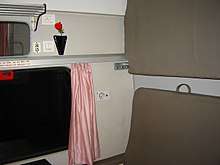
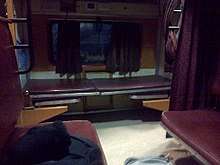

IR has several classes of travel with or without air conditioning; a train may include just one or several of these. Slow passenger trains have only unreserved seating class whereas Rajdhani, Duronto, Shatabdi, Garib Rath and Yuva trains have only air-conditioned classes. The fares are different for each class with unreserved seating class being the cheapest. The fare of Rajdhani, Duronto and Shatabdi trains includes food served in the train, but for other trains food has to be bought separately. From September 2016, the IR have introduced dynamic fares for all accommodation classes for Rajdhani, Duronto and Shatabdi trains (except 1AC and EC classes) to shore up revenue.[67] In long-distance trains a pantry car is usually included and the food is served at the berth or seat itself. Luxury trains such as Palace on Wheels have separate dining cars but fares are comparable to a five-star hotel.
A standard passenger train has four unreserved (also called "general") coaches, two at the front and two at the end, of which one may be exclusively for ladies. The number of other coaches varies according to the demand and route. A luggage coach may be included at the front or back. In some mail trains, a separate mail coach is attached. Lavatories are communal and feature both the Indian style as well as the Western style.
The following table lists the classes in operation. A train may not include all of these classes.
| Class[68] | Description[69][70] |
|---|---|
| Saloon | IR has started to operate saloon coaches to give hotel ambience on trains. These coaches operate on charter basis i.e. booking is required. These have a master bedroom, one normal bedroom, one kitchen and window trailing. Four to six extra beds are given to accommodate more people.[71] First of these coach was attached to Jammu Mail.[72] |
| 1A | AC first class: The most luxurious and expensive class of Indian Railways, with fares almost at par with airfares. There are eight cabins (including two coupes) in full AC first class coach and three cabins (including one coupe) in the half AC first class coach. The coach has an attendant, and bedding is included in the fare. This air-conditioned coach, present only on popular routes, can carry 18 (full coach) or 10 passengers (half coach). |
| 2A | AC two tier: These air-conditioned coaches have sleeping berths across eight bays. Berths are usually arranged in two tiers in bays of six: four across the width of the coach and two lengthwise across the corridor, with curtains along the corridor. Bedding is included in the fare. A coach can carry 48 (full coach) or 20 passengers (half coach). |
| 3A | AC three tier: Air-conditioned coaches with 64 sleeping berths. Berths are similar to 2A, but with three tiers across the width and two lengthwise for eight bays of eight. They are slightly less well-appointed, usually with no reading lights or curtains. Bedding is included in the fare. |
| 3E | AC three tier (economy): Air-conditioned coaches with sleeping berths on the Garib Rath Express. Berths are usually arranged as in 3A, but with three tiers across the width and three llengthwise. Appointments are similar to 3A, and bedding is not included. These coaches are also present in some Duronto Express trains as well. |
| Vistadome | IR operates Vistadome glass roof coaches on some tourist routes. These include Araku Valley, Konkan railway, Kalka-Shimla Railway, Kashmir Valley, Kangra Valley and Neral-Matheran route. These coaches fare are equivalent to AC Executive Chair Car. IR also has plans to start Vistadome on Nilgiri mountain railway.[73] |
| EA | Anubhuthi: Air-conditioned top-end class of Shatabdi Express. These coaches were introduced in January 2018. First train to get these coaches is Chennai Central–Mysuru Shatabdi Express |
| EC | Executive chair car: An air-conditioned coach with spacious seats and legroom. With four seats in a row, it is used for intercity day travel and is available on the Tejas and Shatabdi Express. |
| CC | AC chair car: An air-conditioned coach with five seats in a row, used for intercity day travel. Air-conditioned double-deck coaches are used on the Double Decker Express. |
| SL | Sleeper class: The sleeper class is the most common coach on IR, with ten or more SL coaches attached to a train rake. They are sleeping coaches with three berths across the width and two lengthwise, without air-conditioning. They carry 72 passengers per coach. |
| 2S | Second seater: similar to CC, without air-conditioning. Double-deck second seaters are used on the Flying Ranee. |
| UR/GEN | Unreserved/General: The least-expensive accommodation, with a seat not guaranteed. Tickets are valid on any train on a route if used within 24 hours of purchase. |
At the rear of the train is a special compartment known as the guard's cabin. It is fitted with a transceiver and is where the guard usually gives the all-clear signal before the train departs.
Train types
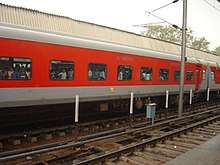
Trains are sorted into categories which dictate the number of stops on a route, their priority on the network and their fare structure. Each express train is identified by a five-digit number. if the first digit is 1 or 2 in the train number, they are long-distance express trains. If the first digit is 0, the train is a special train which will operate for a limited period of time with a different fare structure. A first digit of 5 denotes a passenger train.
The second digit indicates the zone operating the train. However, for high-speed trains, the second digit is either 0 or 2 (the first remains 1 or 2).[74] The third digit denotes the division within the zone which is responsible for maintenance and cleanliness, and the last two digits are the train's serial number.[74] The train numbering system was changed from four digits from December 2010,[75] to accommodate an increasing number of trains.
Trains traveling in opposite directions along the same route are usually labelled with consecutive numbers.[74] However, there is considerable variation in train numbers; some zones, such as Central Railway, have a less-systematic method of numbering trains.[74]
Trains are classified by average speed.[76] A faster train has fewer stops (halts) than a slower one, and is usually used for long-distance travel. Most express trains have special names to identify them easily. The names of the trains usually denote the regions they connect, the routes they traverse; a famous person or a tourist spot connected with the train.[77][78]
| Train types | Description |
|---|---|
| Vande Bharat Express | A semi-high-speed, air-conditioned day time journey train with facilities such as Wi-Fi, snack tables, CCTV cameras, hydraulic-pressure doors and a fire and smoke detection and extinguishing system. It can run at a speed of 200 km/h. It is the first hi-tech Loco-less train set made in India. It was flagged off on 15 February 2019 by Prime Minister Narendra Modi. The model number for this particular train set is Train 18. |
| Tejas Express | A semi-high-speed, air-conditioned train which had its inaugural run on 24 May 2017, covering 551.7 kilometres (343 mi) in eight hours, 30 minutes. Coaches have bio-vacuum toilets, water-level indicators, tap sensors, hand dryers, integrated Braille displays, an LED TV for each passenger with a phone jack, local cuisine, Wi-Fi, tea and coffee vending machines, magazines, snack tables, CCTV cameras and a fire and smoke detection and extinguishing system. It can run at a speed of 200 km/h but it is restricted to 130 km/h due to some technical reasons. |
| Gatimaan Express | The first semi-high-speed, air-conditioned train running between Delhi and Jhansi with a top speed of 160 km/h (99 mph), it is India's fastest train at present. |
| Shatabdi Express | Air-conditioned, intercity trains for daytime travel. Unlike the Rajdhani or Duronto Expresses, the Shatabdi expresses make a round trip on the same day. The Bhopal Shatabdi Express (train number 12001/12002) is India's second-fastest train between New Delhi and Agra, with an average speed of 90 km/h (56 mph) and a top speed of 150 kilometres per hour (93 mph). The limited-stop trains have Wi-Fi. |
| Rajdhani Express | Limited-stop, air-conditioned trains linking state capital to national capital, they have a top speed of 130–140 km/h (81–87 mph). The 2014 railway budget proposed increasing the Rajdhani and Shatabdi Expresses to 180 km/h (110 mph). |
| Duronto Express | Non-stop (except for technical halts) service introduced in 2009. In January 2016, it became possible to book tickets from those technical stops. They connect India's metros and major state capitals, and were introduced to equal (or exceed) the speed of the Rajdhani Express. With air-conditioned one-, two- and three-tier seating, some have non-air-conditioned sleeper-class accommodations. |
| Humsafar Express | Air-conditioned, three-tier coach trains with LED screens displaying information about stations and train speed, a PA system, vending machines for tea and coffee, charging ports for electronic devices, bio-toilets, smoke alarms, CCTV cameras, curtains and heating and refrigeration facilities for food. Inaugural run was between Gorakhpur to Anand Vihar Terminal. |
| AC Express | Air-conditioned, limited-stop trains linking major cities, with a speed of about 130 km/h (81 mph). |
| Double Decker Express | Air-conditioned, limited-stop, two-tier express trains for daytime travel |
| Uday Express | Air-conditioned double decker train for overnight travel. |
| Garib Rath Express | Air-conditioned, economy, three-tier trains with a top speed of 130 km/h (81 mph) |
| Yuva Express | Introduced with the Duronto Express to provide air-conditioned travel to young Indians, 60 percent of its seats were reserved for passengers between 18 and 45 years of age. The trains were unsuccessful, and operate only on the Delhi-Howrah and Delhi-Mumbai routes. |
| Jan Shatabdi Express | A more-economical version of the Shatabdi Express, with air-conditioned and non-air-conditioned classes and a top speed of 110 km/h (68 mph) |
| Sampark Kranti Express | Express service to New Delhi |
| Kavi Guru Express | Introduced in honor of Rabindranath Tagore, four pairs of the trains operate on the network. |
| Vivek Express | Introduced to commemorate the 150th birth Anniversary of Swami Vivekananda in 2013, four pairs of Vivek Expresses run in the country. |
| Rajya Rani Express | Introduced to connect state capitals to major cities in that state. |
| Mahamana Express | Superfast train with Indian Railways ModelRake coaches. |
| Intercity Express | Introduced to connect major cities on short routes with high and semi-high speeds. Trains include the Deccan Queen, Flying Ranee and Bilaspur Nagpur Intercity Express. |
| Antyodaya Express | Non-reserved, high-speed LHB coaches on peak routes to ease congestion. |
| Jan Sadharan Express | Non-reserved express trains on peak routes to ease congestion. |
| Suvidha Express | High priority trains with dynamic pricing on high demand routes. |
| Superfast Express | Trains with a max speed greater than 100–110 km/h (62–68 mph), average speed greater than 55 km/h (34 mph), whose tickets have a superfast surcharge, with stops at very few stations. |
| Express | Trains with a max speed greater than 100 km/h (62 mph), average speed greater than 36 km/h (22 mph), with stops at few stations. |
| These trains earlier had separate mail coaches. Nowadays, mail is carried in luggage coach like all other trains. | |
| Passenger | Slow, economical trains which stop at every (or almost every) station on a route. With generally-unreserved seating. The trains travel at about 40–80 km/h (25–50 mph). |
| Suburban | These trains operate in Mumbai, Delhi, Kolkata, Chennai, Hyderabad, Ahmedabad, Vadodara, Surat, Bengaluru, Pune and between Kanpur and Lucknow, usually stop at every station, and have unreserved seating. |
| Metro | Designed for urban transport, the first metro was the Kolkata Metro. Now Delhi Metro is becoming largest metro network in the country. |
| Mountain Railways | Three of the lines were declared a World Heritage site as Mountain Railways of India by UNESCO.[79] |
Tourism
There are several train services which run for tourists:
- The Palace on Wheels is a luxury-train service, frequently hauled by a steam locomotive, to promote tourism in Rajasthan.[80] The train has a seven-night, eight-day itinerary on a round trip from New Delhi via Jaipur, Sawai Madhopur and Chittaurgarh, Udaipur, Jaisalmer, Jodhpur, Bharatpur and Agra.
- The Royal Rajasthan on Wheels covers a number of tourist destinations in Rajasthan. The seven-day, eight-night tour is a round trip from New Delhi's Safdarjung station via Jodhpur, Udaipur and Chittaurgarh, Ranthambore National Park and Jaipur, Khajuraho, Varanasi and Sarnath, and Agra.[81]
- The Maharajas' Express, a luxury train operated by the Indian Railway Catering and Tourism Corporation (IRCTC), runs on five routes[82] to about 12 destinations across north-West and central India (centered around Rajasthan) from October to April.
- The Deccan Odyssey covers tourist destinations in Maharashtra and Goa. Its seven-night, eight-day tour begins in Mumbai and stops at Jaigad Fort, Ganapatipule and Ratnagiri, Sindhudurg, Tarkarli and Sawantwadi, Goa, Kolhapur and Pune (Day 5), Aurangabad and Ellora Caves, and Ajanta Caves and Nashik.[83] The Golden Chariot runs on two tours: Pride of the South[84] and Splendor of the South.[85]
- The Golden Chariot is a luxury train service which connects tourist destinations in Karnataka, Goa, Kerala & Tamil Nadu.
- The Mahaparinirvan Express, an air-conditioned service also known as the Buddhist Circuit Train, is run by the IRCTC for Buddhist pilgrims. Its seven-night, eight-day tour begins in New Delhi and visits Bodh Gaya, Rajgir and Nalanda, Varanasi and Sarnath, Kushinagar and Lumbini, Sravasti and the Taj Mahal.[86]
- The Fairy Queen, a tourist attraction as the world's oldest operating steam engine, hauls a luxury train from Delhi to Alwar.
Ticketing
India has some of the lowest train fares in the world. Basic passenger traffic is heavily subsidised by more-expensive higher-class fares.[87] Until the late 1980s, Indian Railways ticket reservations were done manually. In 1987 the Railways started using a computerised ticketing system. The entire ticketing system went online in 1995 to provide up-to-date information on status and availability. The ticketing network is computerised to a large extent, with the exception of some remote places. Computerized tickets can be booked for any two points in the country, through the Internet and via mobile phones, though this method carries an additional surcharge.
Discounted tickets are available for senior citizens (above 60 years) and some other categories of passengers including the disabled, students, athletes, persons affected by serious diseases, or persons appearing for competitive examinations. One compartment of the lowest class of accommodation is reserved for ladies in every passenger-carrying train. Some berths or seats in sleeper class and second class are also reserved for ladies.[88] Season tickets permitting unlimited travel on specific sections or specific trains for a specific time period may also be available. Foreign tourists can buy an Indrail Pass,[89] which is modelled on the Eurail Pass, permitting unlimited travel in India for a specific time period.
For long-distance travel, reservation of a berth can be made up to 120 days before departure.[88] Details such as the name, age and concession (if eligible) are required and are recorded on the ticket. The ticket price usually includes the base fare, which depends on the classification of the train (example: super-fast surcharge if the train is classified as a super-fast), the class in which one wishes to travel and the reservation charge for overnight journeys.
If a seat is not available then the ticket is given a waitlist number; otherwise the ticket is confirmed and a berth number is printed on the ticket. A person receiving a wait-listed ticket may be able to obtain a confirmed ticket if there are sufficient cancellations.[88][89] Some of the tickets are assigned to the Reservation against Cancellation (RAC), which is between the waiting list and the confirmed list.[88][89] These allow the ticket holder to board the train and obtain an allotted seat decided by a ticket collector, after the ticket collector has ascertained that a seat is vacant.
Reserved railway tickets can be booked through the website of Indian Railway Catering and Tourism Corporation (IRCTC)[90] and also through mobile phones and SMS. Tickets booked through this site are categorised into iTickets and eTickets. iTickets are booked by a passenger and then printed and delivered to the passenger for carrying during journey. eTickets are printed by the passenger and carried while travelling. While travelling on an eTicket, one must carry an authorised valid photo identity card. Cancellation of eTickets are also done online, without the requirement for the passenger to go to any counter. Unreserved tickets are available for purchase on the platform at any time before departure. An unreserved-ticket holder may only board the general-compartment class. All suburban networks issue unreserved tickets valid for a limited time. For frequent commuters, a season pass (monthly or quarterly) guarantees unlimited travel between two stops.
Freight service
In 1999, the Konkan Railway Corporation introduced the Roll on Roll off (RORO) service, a unique road–rail system, on the section between Kolad in Maharashtra and Verna in Goa,[91] which was extended in 2004 to Surathkal in Karnataka.[92][93] The RORO service, the first of its kind in India, allowed trucks to be transported on flatbed trailers. It was highly popular,[94] carrying about 110,000 trucks and bringing in about ₹740 million worth of earnings to the corporation by 2007.[95]
Urban rail
Suburban rail
The Mumbai Suburban Railway is India's first commuter rail system and transports 7.5 million passengers daily, the highest passenger-density in the world.[96][97] The Kolkata Suburban Railway was established in Kolkata in 1854.[98]
The operational suburban rail systems in India are Mumbai Suburban Railway, Kolkata Suburban Railway, Lucknow–Kanpur Suburban Railway, Chennai Suburban Railway, Delhi Suburban Railway, Pune Suburban Railway, Hyderabad Multi-Modal Transport System, Barabanki–Lucknow Suburban Railway and Pernem–Karwar Suburban Railway.[99] Other planned systems are Bengaluru Commuter Rail, Ahmedabad Suburban Railway and Coimbatore Suburban Railway.
Metro
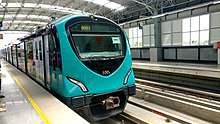
The first modern rapid transit in India is the Kolkata Metro (covers part of Howrah also) which started operations in 1984, as the 17th Zone of Indian Railways.[100] The Delhi Metro in New Delhi (covers parts of Ghaziabad, Noida, Faridabad, Gurgaon and Jhajjar also) is India's second conventional metro and began operations in 2002. The Namma Metro in Bangalore became India's third rapid-transit system in 2011. Following these were Rapid Metro in Gurgaon, Mumbai Metro (covers parts of Palghar, Raigad and Thane also), Jaipur Metro, Chennai Metro, Kochi Metro, Hyderabad Metro, Lucknow Metro, Noida Metro, Nagpur Metro and Ahmedabad Metro (covers part of Gandhinagar also).
Further systems in planning include:surat metro ,Navi Mumbai Metro, Varanasi Metro, Thane Metro, Kanpur Metro, Pune Metro, Vijayawada Metro, Patna Metro, Meerut Metro, Guwahati Metro, Bhopal Metro, Kozhikode Light Metro, Indore Metro, Gorakhpur Metro, Thiruvananthapuram Light Metro, Agra Metro, Coimbatore Metro, Visakhapatnam Metro, Dehradun Metro, Srinagar Metro, Greater Gwalior Metro, Jabalpur Metro and Greater Nashik Metro. Some of these may be under construction and planned to be opened shortly.
Monorail
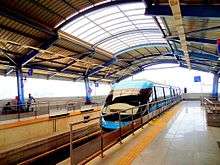
Monorail is generally considered a feeder system for the metro trains in India. The Mumbai Monorail, which started in 2014, is the first operational monorail network in India[101] (excluding the Skybus Metro) since the Patiala State Monorail Trainways closed in 1927.
Other planned systems are Chennai Monorail, Kolkata Monorail, Allahabad Monorail, Bengaluru Monorail, Delhi Monorail, Indore Monorail, Kanpur Monorail, Navi Mumbai Monorail, Patna Monorail, Pune Monorail, Ahmedabad Monorail, Aizawl Monorail, Bhubaneswar Monorail, Jodhpur Monorail, Kota Monorail, Nagpur Monorail and Nashik Monorail.
Light rail
Like monorail, light rail is also considered a feeder for the metro systems. The planned systems are Kolkata Light Rail Transit and Delhi Light Rail Transit.
Tram
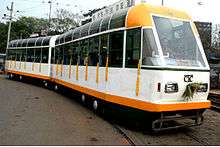
In addition to trains, trams were introduced in many cities in late 19th century, though almost all of these were phased out. The trams in Kolkata are currently the only tram system in the country. The nationalised Calcutta Tramways Company is in the process of upgrading the existing tramway network at a cost of ₹240 million (US$3.4 million).[102]
Private railways
Though state-owned companies like IR and the various metro companies enjoy a near monopoly in India, a few private railways do exist. These private railway lines are used exclusively for freight.
There are railway lines owned and operated by companies including plantations, sugar mills, collieries and other mines, dams, harbours and ports. Private railways are operated by the Mumbai Port Trust, Madras Port Trust,[103] Calcutta Port Trust, Visakhapatnam Port Trust and Bhilai Steel Plant.[103] The Tata Group operate funicular railways at Bhira and at Bhivpuri Road (as well as the Kamshet–Shirawta Dam railway line). The Pipavav Rail Corporation holds a 33-year concession for building and operating a railway line from Pipavav to Surendranagar.[103] The Kutch Railway Company, a joint venture of the Gujarat state government and private parties, is involved (along with the Kandla Port Trust and the Gujarat Adani Port) to build a Gandhidham–Palanpur railway line.[103]
UNESCO World Heritage Sites
There are two UNESCO World Heritage Sites on Indian Railways, the Chhatrapati Shivaji Maharaj Terminus[104] and the Mountain Railways of India.[105] The latter consists of three separate railway lines located in different parts of India: the Darjeeling Himalayan Railway, a 610 mm (2 ft) narrow gauge railway in Lesser Himalayas in West Bengal, the Nilgiri Mountain Railway, a 1,000 mm (3 ft 3 3⁄8 in) metre gauge rack railway in the Nilgiri Hills in Tamil Nadu and the Kalka–Shimla Railway, a 762 mm (2 ft 6 in) narrow gauge railway in the Siwalik Hills in Himachal Pradesh.[105]
Issues
The IR receive rail subsidies of around ₹260 billion ($3.8 billion), 60% of which goes to commuter rail and short-haul trips.[106]
IR earns about 70% of its revenues from freight traffic (₹686.2 billion from freight and ₹304.6 billion from passengers in 2011–12). Most of its profits come from transporting freight, and this makes up for losses on passenger traffic. It deliberately keeps its passenger fares low.
According to the Report of High Level Safety Review Committee of 2012, from 2007–08 to October 2011 casualties in train accidents accounted for 1,019 deaths and 2,118 injuries. In the same period 1,600 railway staff were killed and 8,700 injured. The committee estimated that almost 15,000 persons get killed each year by what is called unlawful trespassing.[107] A Daily Telegraph article stated that Indian Railway officials believe that a large proportion of bodies found dead on railways died elsewhere and were put on the railway in dishonest attempts to get compensation from the railway authorities and companies.[108]
IR announced that by 2022 all trains would be electric to reduce their carbon footprint.[109]
Future
IR's Research Design and Standards Organisation (RDSO) undertakes research, design and standardisation. The railway has undertaken several initiatives to upgrade its ageing infrastructure and improve its quality of service. The Indian government plans to invest ₹9.05 trillion (US$130 billion) to upgrade IR by 2020.[110]
Infrastructure
Infrastructure modernisation projects include high-speed rail, with the first Ahmdabad-Mumbai train in operation in 2025;[111][112][113] redevelopment of 400 stations by monetizing 2,700 acres (1,100 ha) of spare railway land under a ₹1,070,000 crore (US$150 billion) plan;[114] doubling tracks to reduce congestion and delays while improving safety (15,000 km of double track existed in 2016, and funding for 12,500 km more was approved that year);[115] the refurbishing of 12- to 15-year-old coaches at the Carriage Rehabilitation Workshop in Bhopal to enhance passenger amenities and fire safety;[116][117] Global Positioning System (GPS)-enabled tracking of trains to improve safety and service;[118] Digital India-driven ₹3,500,000 million (equivalent to ₹4.0 trillion or US$55 billion in 2019) digitalisation of the railway to improve efficiency and reduce cost;[115] rainwater harvesting, with 1885 systems installed by December 2016,[119] and reforestation of railway land and along the tracks.[120]
Electrification and power
All routes will be electrified to save on imported-fuel costs (48 percent of the network was electrified by May 2016, with full electrification planned by March 2021.[115] Off-the-grid Solar-powered trains are planned with the installation of one gigawatt of solar and 130 megawatts of wind power between 2017 and 2022; India introduced the world's first solar-powered train and 50 coaches with rooftop solar farms in June 2017.[121][122][123] Rooftop solar electricity is planned at stations to reduce long-term fuel costs and protect the environment,[124] and sustainable LED lighting at all stations is planned by March 2018 to cut electricity costs.[125] Locomotive factories have been modernised, including two new factories in Bihar: an electric locomotive factory in Madhepura and a diesel locomotive factory in Marhaura, and 2,285 bio-toilets were introduced from April to July 2014.[126][127][128] A ₹200 billion (US$2.8 billion) partnership with Alstom to supply 800 electric locomotives from 2018 to 2028 was announced.[110]
Safety
Safety projects include the elimination of an average of 1,217 unguarded level crossings per year by building an average of 1,066 overpasses and underpasses per year;[129][115] an automated fire alarm system on Rajdhani Express trains was begun in 2013, extending to the air-conditioned coaches of all trains,[130] and 6,095 GPS-enabled Fog Pilot Assistance System railway signalling devices (replacing the practice of placing firecrackers on tracks to alter train drivers) installed in 2017 in four zones: Northern, North Central, North Eastern and North Western.[131]
See also
- List of railway stations in India
- List of countries by rail transport network size
References
- "Indian Railways Statistical Publications 2016-17: Statistical summary - Indian Railways" (PDF). Ministry of Railway. Retrieved 22 February 2018.
- http://indianrailways.gov.in/railwayboard/uploads/directorate/stat_econ/yearbook10-11/Track_bridges.pdf
- Reporter, Staff. "A bridge over Vembanad Lake". The Hindu. Retrieved 11 February 2017.
- "Indian Railways Statistical Publications 2014–15: The Network" (PDF). Ministry of Railway. Retrieved 9 February 2017.
- "CIA — The World Factbook – Country Comparison :: Railways". CIA. Retrieved 8 July 2009.
- "[IRFCA] India's First Railways". www.irfca.org.
- "164 Years Ago On This Day, India's First Train Ran From Mumbai To Thane".
- "India's 1st train: When Sahib, Sindh & Sultan blew steam - Times of India".
- "Extracts from the Railway Times". Railway Times. 1854. Retrieved 1 January 2019.
- "[IRFCA] Indian Railways FAQ: IR History: Early Days - 1". www.irfca.org.
- "Fairy Queen". www.irctctourism.com. Archived from the original on 21 April 2018. Retrieved 25 January 2019.
- "Legacy of First Railway Station of South India". RailNews Media India Ltd.
- "Kolkata's trams – A ride through history". 2 March 2016.
- "History - The Calcutta Tramways Company [1978] Ltd". calcuttatramways.com.
- "Western Railway". www.wr.indianrailways.gov.in.
- "Eastern Bengal Railway - Graces Guide". www.gracesguide.co.uk.
- indiainfoline.com. "History of Indian Railway Budget".
- http://www.nair.indianrailways.gov.in/uploads/files/1430369423822-operating.pdf
- "Welcome to Official Website of CORE". www.core.indianrailways.gov.in.
- "Deccan Queen Facts - General Knowledge for Kids - Mocomi". 26 January 2012.
- "Frontier Mail". iaslic1955.org.
- "The Grand Trunk Express". iaslic1955.org.
- "Signalling in India - Past and Present". signalbox.org.
- "History of Railways". www.kportal.indianrailways.gov.in. Archived from the original on 21 July 2017. Retrieved 25 January 2019.
- http://www.indianrail.gov.in/ir_zones.pdf
- "160 years of Indian Railways: Here's how AC trains were kept cool". 2 April 2013.
- "Welcome to Official Website of CORE". www.core.indianrailways.gov.in. Archived from the original on 26 September 2015. Retrieved 1 November 2016.
- "Welcome to Official Website of CORE". www.core.indianrailways.gov.in. Archived from the original on 31 March 2016.
- "Metro Railway Kolkata / Indian Railways Portal". www.mtp.indianrailways.gov.in.
- "History of Kolkata Metro Rail Corporation - KMRC". 4 December 2015.
- "Shatabdi Express - Shatabdi Express Train, Shatabadi Express Timetable, Shatabadi Express Schedule Booking India". www.iloveindia.com.
- "North Central Railways / Indian Railways Portal". www.ncr.indianrailways.gov.in.
- http://indiatoday.intoday.in/story/gatimaan-express-reaches-agra-in-targeted-99-minutes/1/635554.html
- http://icisa.cag.gov.in/audit_report/2/15db5cf8539e7f66e05214564e6b5d01.pdf
- "Indian Railway". www.indianrailways.gov.in.
- "IRCTC Next Generation eTicketing System". www.irctc.co.in.
- UK, DVV Media. "Mumbai switches from DC to AC".
- "End of an era: Mumbai bids goodbye to last DC local". 11 April 2016.
- "48 per cent rail tracks electrified, aim to double it in 5 years: Govt". 31 March 2017.
- "India's first CNG train flagged off".
- "New Technology allows Railways to save Rs 20 Lakhs Diesel per Engine". Retrieved 6 September 2013.
- Indian Railways joins 1 billion tonne club in freight loading - Yahoo! News India. In.news.yahoo.com (2 April 2013). Retrieved on 16 July 2013.
- "BLC-A Container Flat Wagon". Titagarh Wagons Limited. Retrieved 27 April 2014.
- "Locomotives — General Information – I". IRFCA.org. Indian Railways Fan Club. Retrieved 4 June 2007.
- "Indian Railways Statistical Publications 2016-17: Statistics for Track and Bridges - Indian Railways" (PDF). Ministry of Railway. Retrieved 22 February 2018.
- "Indian Railways Statistical Publications 2016–17: Statistics for Track and Bridges – Indian Railways" (PDF). Ministry of Railway. Archived (PDF) from the original on 22 February 2018. Retrieved 22 February 2018.
- "Railways opts for standard gauge first time in 160 yrs - Latest News & Updates at Daily News & Analysis". 3 June 2013.
- Central Organisation for Railway Electrification
- "Indian Railways - Statistical Publication 2016-17 - Signalling and Telecom" (PDF). 28 February 2018.
- "Art of the token exchange". Railscapes. 25 July 2017. Retrieved 28 February 2018.
- "Signalling System". IRFCA.org. Indian Railways Fan Club. Retrieved 4 June 2007.
- "[IRFCA] Indian Railways FAQ: Signal Aspects and Indications - Principal Running Signals". www.irfca.org. Retrieved 28 February 2018.
- "Indian Railways clears proposal to equip electric locomotives with European train protection systems- Technology News, Firstpost". Tech2. Retrieved 28 February 2018.
- "Bandhan Express, New Train Between Bengal And Bangladesh: 10 Facts". NDTV.com. Retrieved 16 November 2017.
- "Bandhan Express makes its first commercial run between Kolkata and Khulna today". The Indian Express. 16 November 2017. Retrieved 16 November 2017.
- "Brief on the matter relating to Nepal" (PDF). Official webpage of Indian Railways. Retrieved 1 June 2009.
- Koushik Das. "Construction Work Of New India-Bangladesh Railway Link To Begin In 2015". InSerbia News.
- "Work on new India-Bangladesh railway link from 2015-INews – IBNLive Mobile". IBNlive. 18 June 2014.
- "Indian Railway to build a 15-km track linking Agartala with Bangladesh".
- "Work on Agartala-Akhaura rail link to commence soon". The Times of India.
- "Work on new India-Bangladesh railway link from 2015". The Times of India.
- "India, Bangladesh align rail link in Tripura". Meghalaya Times. Archived from the original on 6 October 2014. Retrieved 25 January 2019.
- "India's rail-building challenge". By Sudha Ramachandran. Asia Times. 3 January 2007. p. 2. Retrieved 16 April 2009.
- "India signs trans-Asian railways pact". Indo-Asian News Service. 2 July 2007. p. 1. Retrieved 16 April 2009.
- "IRFCA:Indian Railways FAQ:Geography:International". IRFCA, website of the Indian Railway Fan Club. Retrieved 24 June 2009.
- Railways revise station categories to improve services, Economic Times, 28 Dec 2017.
- "Premium railway fares hiked up to 50 per cent in new dynamic pricing model". 8 September 2016. Retrieved 8 September 2016.
- "Accommodation Classes in Indian Railways". Indian Railways. Archived from the original on 26 April 2017. Retrieved 15 November 2016.
- "General Information on travelling by IR". IRFCA.org. Indian Railways Fan Club. Retrieved 3 June 2007.
- "Class of Travel". indiarail.co.uk. S.D. Enterprises Ltd. Archived from the original on 13 May 2007. Retrieved 3 June 2007.
- Saloon Coaches
- Saloon attached to Jammu Mail
- Vistadome on Nilgiri Mountain Railway
- "The system of train numbers". IRFCA.org. Indian Railways Fan Club. Retrieved 3 June 2007.
- "New Train Number Enquiry". Indian Railways Passenger Reservation Inquiry. Centre For Railway Information Systems. Retrieved 5 February 2011.
- "railway operations — I". IRFCA.org. Indian Railways Fan Club. Retrieved 11 June 2007.
- "Train names". IRFCA.org. Indian Railways Fan Club. Retrieved 3 June 2007.
- Sekhsaria, Pankaj (24 June 2005). "What's in a Train Name?". The Hindu Business Line. Archived from the original on 8 June 2007. Retrieved 4 June 2007.
- "Toy Trains of India". Our Trips – Royal Train Tours. India Calling Tours (P) Limited. Archived from the original on 8 August 2007. Retrieved 12 May 2007.
- "NPalace on wheels – Exclusive Indian train was originally used by royalty". Times of India. 13 October 2012. Archived from the original on 17 October 2012.
- "Royal Rajasthan on Wheels Itinerary | Tour Program for 2014–15". Royalsrajasthanonwheels.com. Archived from the original on 31 March 2014. Retrieved 27 April 2014.
- "The Maharajas' Express Train Journeys Season 2014–2015". The-maharajas.com. Archived from the original on 28 February 2014. Retrieved 27 April 2014.
- "Ministry of Railways (Railway Board)". Archived from the original on 5 November 2013. Retrieved 26 January 2014.
- "Tour Itinerary – Tour Itinerary of Golden Chariot Train, Itinerary of Golden Chariot Train". Goldenchariottrain.com. Archived from the original on 14 April 2014. Retrieved 27 April 2014.
- "Southern Splendour Tour – South India Tour and South India Tour Package". Goldenchariottrain.com. Archived from the original on 14 April 2014. Retrieved 27 April 2014.
- "Ministry of Railways (Railway Board)". Indianrailways.gov.in. Archived from the original on 10 April 2014. Retrieved 27 April 2014.
- Joshi, V; I. M. D. Little (17 October 1996). "Industrial Policy and Factor Markets". India's Economic Reforms, 1991–2001. USA: Oxford University Press. p. 184. ISBN 0-19-829078-0. Retrieved 25 June 2007.
- "Reservation Rules". Indian Railways. Archived from the original on 24 June 2007. Retrieved 25 June 2007.
- "General Information on travelling by IR". Travelling by Train in India, IRFCA.org. Indian Railways Fan Club. Retrieved 11 June 2007.
- "Indian Railway Catering and Tourism Corporation Limited". www.irctc.co.in. Archived from the original on 3 March 2007. Retrieved 3 June 2007.
- "Road-Rail Synergy System". Press release, Press Information Bureau, dated 2004-20-05. Retrieved 22 December 2008.
- "New Konkan Rly service begins". Online edition of the Business Standard, dated 2004-06-16. Retrieved 22 December 2008.
- "RORO service again on Konkan Railway". Online edition of The Hindu Business Line, dated 2004-06-11. Retrieved 22 December 2008.
- S. Vydhianathan. "Convergence on the Konkan Railway". Online edition of The Hindu, dated 2003-14-11. Archived from the original on 27 June 2006. Retrieved 22 December 2008.
- "ROLL ON- ROLL OFF (RORO) SERVICE ON KONKAN RAILWAY" (PDF). Official webpage of the Konkan Railway Corporation. Archived from the original (PDF) on 4 March 2009. Retrieved 22 December 2008.
- "Overview Of the existing Mumbai Suburban Railway". Mumbai Railway Vikas Corporation. Archived from the original on 20 June 2008. Retrieved 31 March 2009.
- "It's not getting any better! Despite metro and monorail, Mumbai local trains getting more overcrowded". mid-day. Archived from the original on 13 April 2017. Retrieved 13 April 2017.
- "Opening up new frontiers". The Hindu Business Line. 27 October 2006. Retrieved 5 April 2010.
- Sanjay K. Singh. "Review of Urban Transportation in India" (PDF). Journal of Public Transportation, Vol. 8, No. 1, 2005. Retrieved 23 June 2009.
- "Kolkata Metro is now the 17th zone of Indian Railways – The Times of India". The Times Of India.
- "Mumbai monorail to run in two years". The Times of India. 27 September 2007. Retrieved 19 March 2009.
- "Kolkata's trams to sport a new look soon". Online edition of the Times of India, dated 2009-03-11. 11 March 2009. Retrieved 17 April 2009.
- "Railways other than IR in India". IRFCA.org. Indian Railways Fan Club. Retrieved 18 June 2007.
- "Chhatrapati Shivaji Maharaj Terminus (formerly Victoria Terminus)". World Heritage List. World Heritage Committee. 2004. Retrieved 5 January 2009.
- "Mountain Railways of India". World Heritage List. World Heritage Committee. 1999. Retrieved 5 January 2009.
- "Govt defends fare hike, says rail subsidy burden was too heavy".
- Report of High Level Safety Review Committee Archived 14 July 2014 at the Wayback Machine, Railway Ministry, February 2012
- Daily Telegraph, Wednesday 18 April 2012 issue, page 14, rightmost column)
- Sood, Jyotika (18 January 2017). "Prabhu unveils 10-year energy plan for Railways to save Rs41,000 crore". livemint.com. Retrieved 22 June 2017.
- "GE, Alstom land $5.6-billion deals to supply locomotives for railways". Economic Times. 10 November 2015. Retrieved 13 November 2015.
- Diamond quadrilateral of high-speed trains - A Dastidar, Indian Express, 10 June 2014
- India to sign deal with Japan to get first bullet train - The Hindu
- India Said to Pick Japan for High-Speed Rail Project - WSJ
- Railways appoints IRSDC as nodal agency for station redevelopment, Livemint, 5 December 2017.
- Indian Railways orders conversion to Broad Gauge, Rail Digest, 12 April 2017.
- "Indian Railways gets first model rake of luxury 'Make in India' coaches". The Economic Times. Bennett, Coleman & Co. Ltd. 11 January 2016. Retrieved 13 January 2016.
- "Indian Railways unveils 'Make in India' train coaches with new look". The Financial Express. The Indian Express Group. 13 January 2016. Retrieved 13 January 2016.
- "Just like your cabs, you can soon track trains in real time via GPS | Latest News & Updates at Daily News & Analysis". dna. 30 November 2017. Retrieved 30 November 2017.
- Rain Water Harvesting System In Indian Railway, 7 December 2016.
- India Plants 50 Million Trees in One Day, Smashing World Record, National Geographic, July 2016.
- "India's first solar-powered DEMU train launched". The Hindu. Retrieved 23 July 2017.
- Railways, IIT-Madras tie up to power AC coaches with solar energy | News | Eco-Business - Asia's Cleantech & Sustainable Business Community. Eco-Business (5 August 2013). Retrieved on 17 August 2013.
- India’s new solar-powered train is the first in the world, June 2017
- "NORTHERN RAILWAYS TO INSTALL 5 MW ROOFTOP SOLAR IN FOUR OF ITS STATIONS". Archived from the original on 3 March 2017. Retrieved 25 January 2019.
- Indian Railways plans to make all stations 100% LED lit by 31 March 2018, Times of India, 19 December 2017.
- "Locomotive Factories in Bihar: In cold storage for years, two Railway projects to start soon". Indian Express. 30 October 2015. Retrieved 31 October 2015.
- "GE Gets $2.6 Billion Indian Railways Contract". Wall Street Journal. 9 November 2015. Retrieved 9 November 2015.
- "Rail ministry awards Rs 14,656-cr Marhowra locomotive project to GE". Business Standard. 9 November 2015. Retrieved 9 November 2015.
- Indian Railways commissions around 4800 kilometer of broad gauge track in last two financial years which is a record performance , 12 May 2016.
- "Indian Railways develops Automatic Fire and Smoke Detection System". Retrieved 5 September 2013.
- "Indian Railways to use GPS-enabled devices to fight fog this season", The Economic Times, 12 December 2017.
Further reading
- Aguiar, Marian. Tracking Modernity: India's Railway and the Culture of Mobility (University of Minnesota Press; 2011) 226 pages; draws on literature, film, and other realms to explore the role of the railway in the Indian imagination. excerpt and text search
- Bear, Linda. Lines of the Nation: Indian Railway Workers, Bureaucracy, and the Intimate Historical Self (2007) excerpt and text search
- Kerr, Ian J. Railways in Modern India (2001) excerpt and text search
- Kerr, Ian J. Engines of Change: The Railroads That Made India (2006)
- Kumar, Sudhir, and Shagun Mehrotra. Bankruptcy to Billions: How the Indian Railways Transformed Itself (2009)
- "IRFCA : FAQ - Table of Contents". Indian Railways Fan Club. Retrieved 19 June 2005.
- "IRCTC". Indian Railways. Retrieved 19 June 2005.
External links
| Wikivoyage has a travel guide for Rail travel in India. |
| Wikimedia Commons has media related to Rail transport in India. |
- Indian Railways – official website
